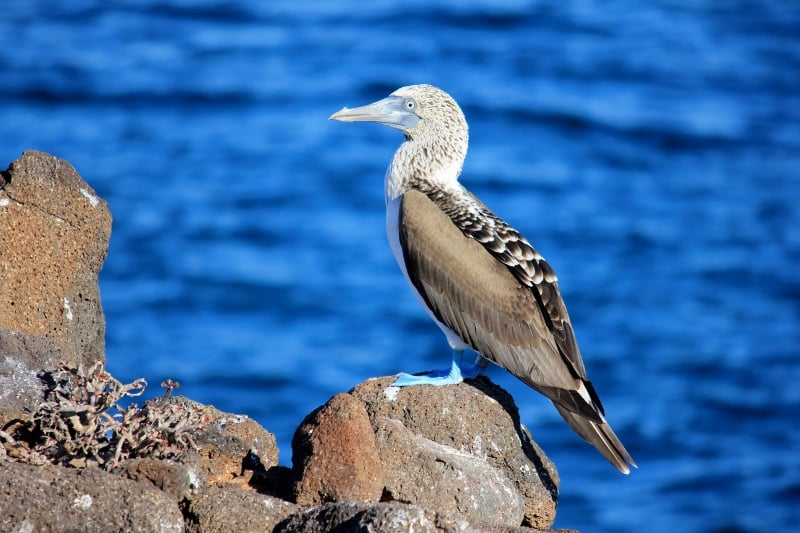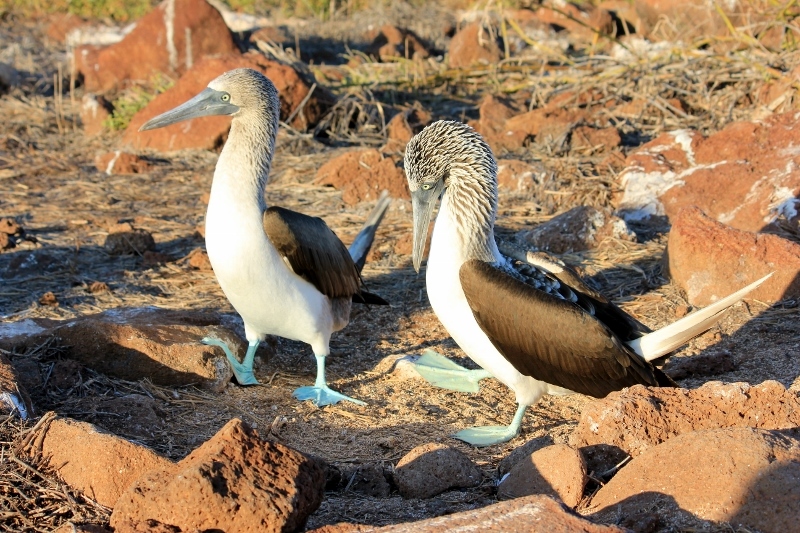Peter was excited when I told him we would be traveling to Ecuador and going on a cruise with Ecoventura to the Galápagos Islands, even more enthusiastic when I informed him that he would be seeing hundreds of boobies. What I failed to mention was that these Boobies weren’t of the well-endowed female sort, they were the native Blue-footed Booby bird which just happened to own a very breasty name.
He would find out soon enough.
There are actually 3 types of boobies on the Galápagos Islands: Blue-footed, Red-footed and Nazca. Though we would most likely be seeing them all, my real bucket list goal was to witness a Blue-footed Booby mating dance.
Prior to arriving in Ecuador and the Galapagos Islands, I had heard the most about these Blue-Footed Booby birds, which made them the most coveted on my booby hunt. The want grew even greater after learning about their unique courting ritual, which included rocking side-to-side while lifting their eye-catching baby blue feet. A Booby dance.
These birds really needed to be able to do some fancy foot work in order to woo their woman.
Maybe Peter could learn a few new dance moves. It was about time he graduated from his old standbys, “The Sprinkler” and “The Lawnmower”.
We started on San Cristobal Island where the Red-footed Boobies were scarce, but we spotted a few sitting in their nests atop their eggs, which made it difficult to actually see their red feet.
On Espanola Island, there were a lot of baby Boobies.
The Nazca Booby is one of the least talked about of the boobies, yet just as beautiful as the rest and their babies were simply adorable balls of puff.
All along our route, there was a scattering of Blue-footed Boobies.
When I spotted my first one it was exciting, not so much for Peter who was beginning to realize that these boobies weren’t exactly what he expected.
Though, they were plentiful, confirming my claim to him that he would be seeing more boobies than he ever did in Las Vegas. See, I didn’t lie, unless omission is lying.
Even with numerous booby sightings we had yet to see the actual Blue-footed Booby mating dance. Then, on our last day of exploring the Galapagos Islands, on North Seymour, we saw one very popular female bird surrounded by a few male Boobies who were strutting their stuff trying to impress this desirable lady.
I wish I was so popular.
We watched as they did their dance, battling it out like a fierce episode of Dancing with the Stars. But, there was a clear leader in this bunch…

In the end, Peter had to admit that these kind of Boobies were fun too. And he even created his own rendition of a Booby dance…

How many times the word Booby/Boobies is mentioned in this article: 21
Will traveling to Galapagos Islands be on your bucket list? What about seeing the Blue-footed Booby mating dance?
. . . Read More. . .
21 Photos to Inspire Your Galapagos Bucket List
Hike to the top of Bartolome Island in the Galapagos
See Galapagos Penguins in the Wild
. . . Check it Off Your Bucket List . . .
Location/Facts:
Situated in the Pacific Ocean, the Galapagos Islands are a volcanic archipelago that lie 620 miles from the South American mainland. A province of Ecuador, it consists of 13 main islands and 6 smaller isles. It is a remote destination that is a melting pot of unique wildlife, which inspired Charles Darwin’s landmark theory of evolution following his visit in 1835. Have been called a “living museum and showcase of wildlife” it is home to wildlife species that are found nowhere else on Earth; the giant tortoise, Galapagos sea lions, Flightless Cormorant, the Waved Albatross and, of course the boobies.
Getting There:
Galapagos is reached through the country of Ecuador by flying into either the capital city of Quito or the countries largest city of Guayaquil. If you don’t plan on spending any time on the mainland, fly into Guayaquil, since it is closer to the islands and most flights from Quito to the Galapagos stop there. If you plan on doing some exploring in Ecuador prior or after your trip, go to Quito. Its famous old town is an UNESCO World Heritage Site filled with colonial charm, bustling markets and architectural buildings. Whichever city you choose, will most likely require an overnight stay.
The Galapagos Islands has two airports, one on San Cristóbal and the other on Isla Baltra, just north of Santa Cruz. Which airport you choose will depend on how you have decided to explore the islands. The flight from Guayaquil to the islands is approximately an hour and forty-five minutes (about 40 minutes from Quito to Guayaquil). Domestic flights can be booked through TAME, Avianca or LAN.
Language(s):
Spanish is the official language in Ecuador and on the Galapagos Islands, though English is widely spoken on tours, plus in the restaurants and hotels.
Currency:
The US Dollar
Electricity:
Plug Type A/B, 110v. The voltage and socket is the same as the U.S., so there is not need for an adapter or converter.
When to Go:
Every month in the Galapagos has its highlights and the weather makes any time of the year a good time to visit, so when you go greatly depends on the type of experience you are looking to have.There is always something incredible to see on the Galapagos. But, in May your chances increase for witnessing the blue-footed booby mating dance on North Seymour. For a complete list of wildlife activity check out the monthly calendar at Ecuador Travel Site.
The peak tourism months are June, July and August, as well as mid-December through mid-January. You should book your trip well in advance during these times, as the number of visitors allowed on the islands is limited. Be aware that the prices are also often higher during this time. December through May is when the sea tends to be the calmest. In these months the weather is hotter and slightly rainy with temperatures typically in the 80s. On most days the sun will still make an appearance after the rainfall. June through November brings cooler temperatures (in the 70s) and colder water. Experienced divers prefer this time of year, as the currents bringing nutrients into the water draws more amazing marine life.
How to Visit/Planning:
One of the biggest decisions to make when planning your travel to Galapagos is how you will choose to explore the islands. You can either take a cruise on a live-aboard boat or stay onshore using a hotel as your base. If you select the latter, it is possible to book day trips to some of the popular islands from Santa Cruz or San Cristobal. Though this may be a more economical option, getting around independently can be challenging, as exploring most of the islands requires being accompanied by a licensed guide. Plus, you will have limitations to the islands you can reach due to the distance. The advantage to a multi-day live-aboard cruise is that they leverage the night hours by using them to travel between islands, so your days are not wasted. The small group yachts, under 20 passengers, are the best way to explore the islands and see more of the wildlife in a personalized environment. There are dozens, if not hundreds, of licensed vessels with a variety of stops and routes to choose from. Ecoventura is the sustainable travel company who took me through the islands, and is ideal for those wanting a small group experience with educated naturalists. If you opt for day trips from the main islands, Sharksky offers good options. The best solution may be to take a 4-day cruise then spend a couple days on your own on a populated island, like Puerto Ayora in Santa Cruz or Puerto Baquerizo Moreno in Cristóbal.
Getting Around:
Navigating between the islands will require a plane or boat. Though for getting around on the populated islands you can rent a bike for about $15 per day or catch a taxi for a couple of bucks to most destinations.
Where to Stay:
If you are staying overnight in Guayaquil, try Hotel Oro Verde (from $124), which offers shuttle service from the airport or for a more peaceful stay in a quiet residential area, Nazu House Bed & Breakfast (from $86). In Quito, splurge at Hotel Patio Andaluz (from $210) centrally located in the historic district or hideaway at Las Terrazas de Dana (from $109), a modern ecolodge in the cloud forest of Mindo. In the Galapagos, stay in the lap of luxury at Finch Bay Eco Hotel (from $325) on Santa Cruz Island or the family run Galapagos Suites (from $134). On San Cristóbal, try the simple Galapagos Eco Friendly (from $89) that has all you need.
Where to Eat:
While in Quito, get your ceviche fix at Zazu (www.zazuquito.com) or indulge in traditional Ecuadorian dishes and pasta at Fried Bananas Café (www.newfriedbananas.com), make sure to order the fried banana dessert made with vodka. In Guayaquil, try local foods with a trendy twist at La Pizarra (www.facebook.com/lapizarraec) or opt for Noe (www.noesushibar.com), known as the place to go for great sushi. On the island of Santa Cruz have a casual dinner at Calle de los Kioscos, an open-air market with plenty of cheap local food choices. For outdoor dining, head over to La Garrapata (+593 5-252-6264) for the fresh tuna in a sesame and pepper sauce. For a local experience on San Cristóbal, get burgers at Cri’s (www.facebook.com/CrisBurgerFactory) and eat on the tiny stools out front.
Bucket List Must-Dos:
- Plan your trip around the month of May to get a better chance of witnessing the Blue Footed Booby mating dance, the courtship ritual of these popular birds.
- Take the steep climb to the top of the volcanic cone of Bartolomé and get a peak at the most photographed natural structure in the Galapagos, Pinnacle Rock.
- Do as the sailors did in the 19th century and send a post card at Post Office Bay on Floreana Island. Leave one and sift through the others to pick one close to home to hand deliver.
- Take a closer look at the giant tortoises at the Darwin Research Station (www.darwinfoundation.org) in Puerto Ayora where scientists and volunteers are involved in conservation.
- Snorkel through the network of lava tunnels known as Los Tuneles on isle Isabela. The unique formations above and below the water include a series of arcs and tunnels that are a sanctuary of marine life.
Essential Information:
- It is a requirement to have a naturalist with you when exploring the protected islands; you cannot just venture off on your own.
- Though you may be able to hop onto a last-minute cruise when you reach the islands, it’s best to book well in advance, at least 3-4 months during non-peak times and 6 months to a year during high tourist months.
- When arriving to either of the two Galapagos airports, travelers must pay a $100 per person ($50 for children under 12) Galapagos National Park (galapagospark.org) entrance fee at immigration.
- A visa is not required to enter Ecuador, though make sure your passport does not expire within 6 months of arrival.
- It is strictly prohibited to touch or otherwise disturb the nature or wildlife of the Galapagos. Do not feed the animals (not even a drop of water) or leave behind any sort of litter.
Packing Tips:
- Exploring the Galapagos typically means being on a boat, so make sure that you load up on motion sickness medication. Some days can get pretty choppy and seasickness can even affect those not prone to it. Try the sea-band wristband or Dramamine’s less drowsy formula.
- Be kind to the ecosystem by bringing biodegradable sunscreen, shampoo, conditioner and lotions. (Alba Botanica makes a highly rated sunscreen and Campsuds makes a multi-purpose cleaner that can be used as a shampoo, body wash or even dish cleaner.)
- A small pair of binoculars can go a long way when trying to spot wildlife from the boat. (Bushnell Falcon makes some nice ones for under $30)
- Limit plastic waste by bringing a reusable water bottle. (The Vapor Element Bottle is perfect for travel since it folds up into a tiny neat package when empty)
- Bring the right pair of shoes. Light hiking shoes are necessary for some of the islands and water shoes are needed for the wet landings when the panga can’t bring you all the way to the shore or dock. A dual-purpose Keen style active shoe would work well. Also, bring a comfortable pair of deck shoes to wear while just hanging out on the boat.
- Don’t forget an underwater camera to capture the incredible marine life. I use a GoPro, but if you want a cheaper option just get an underwater case for your phone.
- Most tours will provide snorkeling gear (masks, tube, fins and wet suit), but consider at least bringing your own mask. A properly fitted one can enhance your snorkel experience and lessen the chances of missing marine-life because of having to fiddle with your gear.
- You can leave the makeup and blow dryers at home since you will most likely be in and out of the water several times per day.
- Bring a small daypack to take along on the hikes.
- Pack a dry bag to store all your electronics. It can get tricky moving from the small panga to shore while carrying your camera equipment and you want to make sure it is protected.
- If you are taking a cruise, there will be some down time and very limited Internet. Bring a book or download movies to your laptop prior to leaving home.
- It gets hot in the Galapagos and a long-sleeved UPF shirt to protect you from the sun while hiking or snorkeling can save your shoulders from a brutal burn.
Helpful Websites:
Galapagos Conservancy www.galapagos.org
This post was provided in a partnership with Ecoventura. All opinions are my own. This post may contain affiliate links. If you make a purchase through my links, I earn a commission that helps to keep this blog running—at no extra cost to you. For more information read my full disclosure.
You Might Also Enjoy
Galapagos Islands Animal Bucket List: 40 Wildlife to Spot
Insider Tips to Conquering Peru’s Classic Inca Trail to Machu Picchu Hike




TY so much for this article :)
Thank you for reading it :)
entertaining story :) like how you tricked Peter :P
Playing little jokes on him gives me lots of pleasure. Though, I am sure one day he will pay me back ;)
Baby boobies!! So cute!
Aren’t they? They looked so soft!
Are Blue-footed Booby birds already one of the endangered species?
I believe that the Blue-footed Booby was one on the endangered species list, but is no longer.
Umm Peter should probably go back to the Lawnmower…his booby dance is terrible ;-)
LOL! I was lucky to get him to even do that dance. But, his lawnmower is pretty darn good :)
What funny little creatures and what an awesome experience you guys had Annette!
They were very unusual birds and so much fun to watch!
Awesome photos!! These little guys are so cute. And love the dancing! :)
Thanks! Their dancing is quite mesmerizing since it seems like they are doing it in slow motion.
Haha, I had NO idea there was a bird breed called such a thing!;-) Love that shot of mamma bird feeding her baby, so sweet!
That is one of my favorite shots too :)
They are cute! And exhibitionist haha – can’t believe they didn’t care that you guys were around…I guess nature calls =)
If they are exhibitionists, then I guess we were voyeurs ;)
Thanks for sharing this story, these birds look absolutely stunning! :)
Your blog is very nice, I’m constantly watching. Also I think your site is very up to date. This article was descriptive and a great article.
They look adorable, love their little blue feet, so cute :)
this is amazing!! we went.. but maybe it wasn’t mating season. all they did was sit around and sometimes fly. :) we did see one dive into the water.. but of course i missed the photo bc i was in shock with what i was seeing.
Did you go to the G’islands because of this bird? Seems very cool! Just followed you on Twitter as well – cool site. Looking forward to connect! Torsten
Not solely because of the Blue-footed Boobies, but it definitely played a little part.
I have been fascinated with these birds ever since seeing a photo of them on another travel blog but thanks so much for featuring them and talking about them so detailed. I also really want to go to the Islands to see them.
The video was really interesting,… the birds…. not the much Peters haha… he would not do very well in the bird mating world :P
Poor Peter…luckily he’s not a bird ;)
All the birds on the Galapagos Islands where so interesting, but these were my 2nd favorite (the penguins being the first).
Annette, I came across your great blog while planning for our trip. Maybe I missed it, but what time of the year did you all go? thanks. Matt
How exciting for you! I went to the Galapagos in March and the weather was pretty perfect. Plus, it was also nice because there were less tourists than in the summer time.